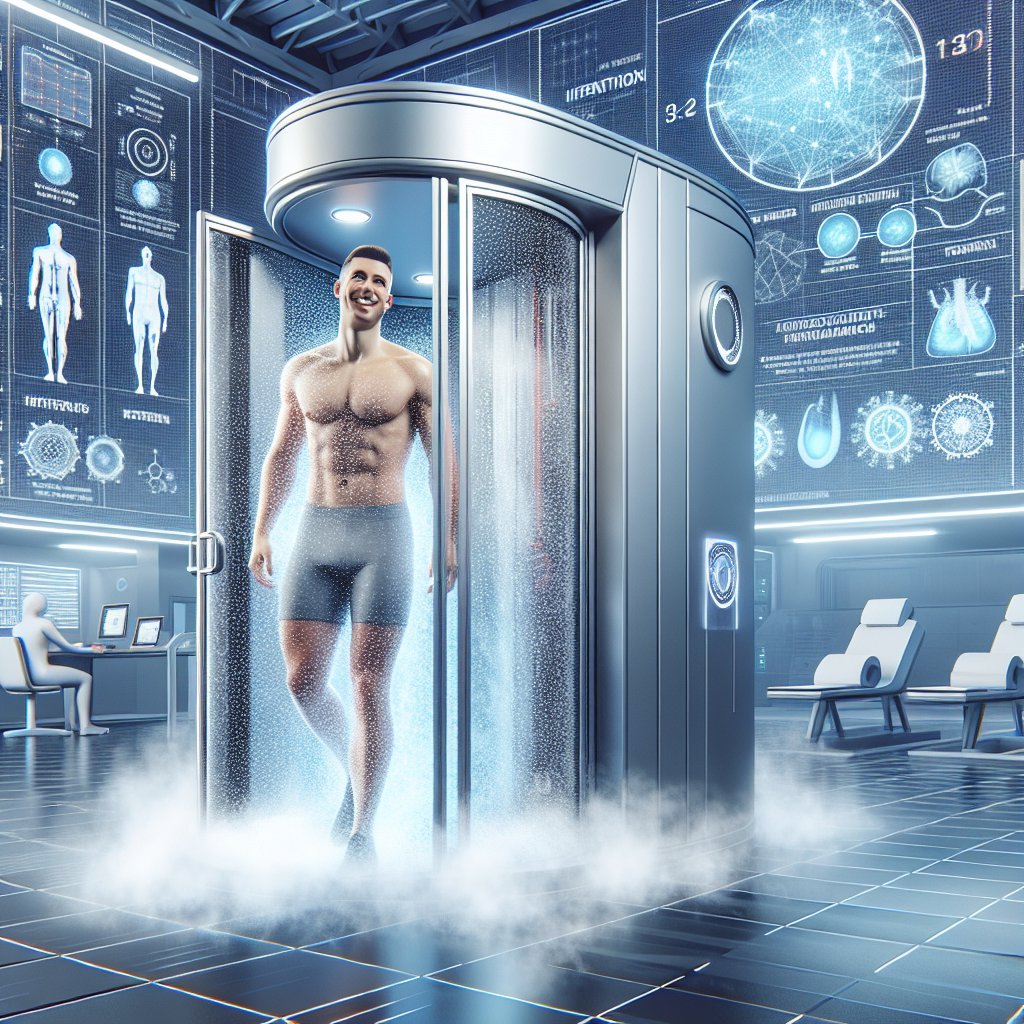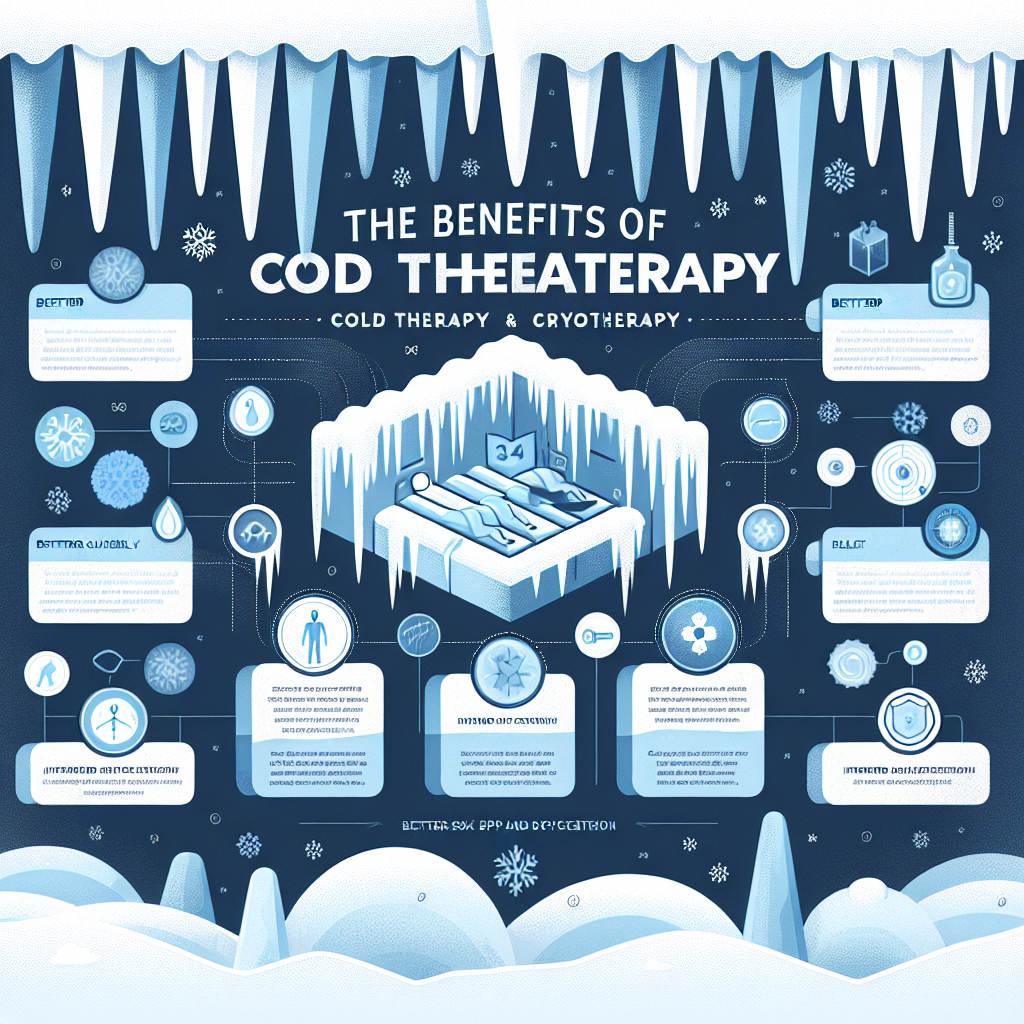The Benefits of Cold Therapy and Cryotherapy

Discover the numerous benefits of Cold Therapy and Cryotherapy today! Enhance your recovery, boost your immune system, and improve your overall health. Don’t wait, start your journey to a healthier you now. Click here to learn more.
Exploring the Health Advantages of Cold Therapy and Cryotherapy
Cold therapy and cryotherapy have been gaining popularity in recent years, not only among athletes and fitness enthusiasts but also among those seeking to improve their overall health and wellbeing. These treatments, which involve the use of low temperatures in medical therapy, offer a myriad of health benefits, from pain relief to enhanced recovery and improved sleep.
One of the most significant benefits of cold therapy and cryotherapy is their ability to alleviate pain and inflammation. When the body is exposed to cold temperatures, it responds by constricting blood vessels, which can help to reduce swelling and inflammation. This can be particularly beneficial for individuals suffering from conditions such as arthritis or those recovering from injuries. Moreover, the cold can numb the affected area, providing immediate relief from pain.
In addition to pain relief, cold therapy and cryotherapy can also aid in recovery after physical exertion. Athletes often use these treatments to speed up their recovery process after intense workouts or competitions. The cold helps to reduce muscle soreness and fatigue, allowing athletes to return to their training routines more quickly. Furthermore, some studies suggest that cold therapy can also help to repair muscle damage and improve performance.
Another notable benefit of cold therapy and cryotherapy is their potential to boost the immune system. Exposure to cold temperatures can stimulate the body’s metabolic rate and increase the production of white blood cells, which play a crucial role in fighting off infections and diseases. This can help to strengthen the immune system and improve overall health.
Cold therapy and cryotherapy can also contribute to better sleep. Many people find that they sleep more soundly after a session of cold therapy, as the treatment can help to reduce anxiety and promote relaxation. Moreover, the cold can help to regulate body temperature, which is a key factor in achieving restful sleep.
While the benefits of cold therapy and cryotherapy are numerous, it’s important to note that these treatments may not be suitable for everyone. Individuals with certain health conditions, such as Raynaud’s disease or cardiovascular disease, should consult with a healthcare professional before trying these therapies. Additionally, it’s crucial to ensure that cold therapy is administered correctly to avoid frostbite or other potential complications.
In conclusion, cold therapy and cryotherapy offer a range of health benefits, from pain relief and enhanced recovery to improved sleep and a stronger immune system. These treatments can be a valuable addition to a holistic approach to health and wellbeing. However, as with any therapy, it’s important to use them responsibly and under the guidance of a healthcare professional. Whether you’re an athlete looking to speed up recovery, an individual suffering from chronic pain, or simply someone seeking to improve your overall health, cold therapy and cryotherapy may be worth considering.
The Role of Cryotherapy in Sports Recovery and Performance Enhancement

Cryotherapy, also known as cold therapy, has been gaining popularity in the world of sports and fitness. This innovative treatment, which involves exposing the body to extremely cold temperatures for a short period of time, has been lauded for its numerous benefits, particularly in the realm of sports recovery and performance enhancement.
Athletes, both professional and amateur, are constantly pushing their bodies to the limit. This intense physical exertion often results in muscle soreness, inflammation, and fatigue. Traditionally, these issues have been addressed through methods such as rest, massage, and the application of heat or ice. However, cryotherapy has emerged as a more efficient and effective solution.
One of the primary benefits of cryotherapy is its ability to reduce inflammation. Inflammation is the body’s natural response to injury or strain, but excessive inflammation can hinder recovery and lead to chronic pain. Cryotherapy works by causing the blood vessels to constrict, thereby reducing blood flow to the inflamed area and alleviating pain and swelling. This can significantly speed up the recovery process, allowing athletes to return to their training regimen more quickly.
In addition to its anti-inflammatory effects, cryotherapy also aids in muscle recovery. The cold temperatures stimulate blood circulation, driving oxygen-rich blood to the muscles. This helps to flush out toxins and lactic acid, which are byproducts of intense physical activity that can cause muscle soreness and fatigue. By promoting faster muscle recovery, cryotherapy can help athletes improve their performance and endurance.
Cryotherapy also has a positive impact on the nervous system. The cold temperatures trigger the release of endorphins, the body’s natural painkillers, which can help to alleviate pain and promote a sense of well-being. This can be particularly beneficial for athletes who are dealing with chronic pain or injury.
Moreover, cryotherapy has been found to enhance sleep quality. Good sleep is crucial for athletic performance and recovery, as it is during sleep that the body repairs and regenerates tissues. The endorphins released during cryotherapy can help to promote deeper, more restful sleep, further aiding in recovery and performance enhancement.
While the benefits of cryotherapy are impressive, it’s important to note that this treatment is not a magic bullet. It should be used in conjunction with a balanced diet, regular exercise, and adequate rest. Furthermore, cryotherapy may not be suitable for everyone. Individuals with certain medical conditions, such as Raynaud’s disease or cardiovascular disease, should consult with a healthcare professional before trying cryotherapy.
In conclusion, cryotherapy offers a host of benefits for athletes, from reducing inflammation and promoting muscle recovery to enhancing sleep quality and boosting endorphin levels. By incorporating cryotherapy into their recovery regimen, athletes can potentially improve their performance and reduce their risk of injury. As with any treatment, it’s important to use cryotherapy responsibly and under the guidance of a healthcare professional. With its myriad benefits, it’s no wonder that cryotherapy is becoming a staple in the world of sports recovery and performance enhancement.
Understanding the Benefits of Cold Therapy in Pain Management and Inflammation Reduction
Cold therapy, also known as cryotherapy, has been gaining popularity in recent years due to its numerous health benefits. This therapeutic technique involves the use of cold temperatures to treat various ailments, particularly those related to pain and inflammation. The benefits of cold therapy are manifold, and understanding these can provide a new perspective on pain management and inflammation reduction.
Cold therapy works by reducing blood flow to a particular area, which can significantly reduce inflammation and swelling that causes pain, especially around a joint or a tendon. It can temporarily reduce nerve activity, which can also relieve pain. This form of therapy is often used to alleviate acute injuries, such as sprains and strains, as well as chronic conditions like arthritis.
One of the primary benefits of cold therapy is its effectiveness in pain management. When applied to the affected area, the cold temperature numbs the nerve endings, reducing the sensation of pain. This effect is similar to local anesthesia, providing temporary relief from discomfort. For individuals suffering from chronic pain, cold therapy can be a non-invasive and drug-free alternative to traditional pain medications, which often come with side effects.
In addition to pain management, cold therapy is also highly effective in reducing inflammation. Inflammation is the body’s natural response to injury or infection, but when it becomes chronic, it can lead to various health problems. By constricting blood vessels and slowing down metabolic activity, cold therapy reduces the body’s inflammatory response. This not only helps in managing the symptoms of chronic inflammatory diseases but also aids in faster recovery from acute injuries.
Cryotherapy, a more advanced form of cold therapy, involves exposing the body to extremely cold temperatures for a few minutes. This method is believed to have additional benefits, including boosting the immune system, improving circulation, and enhancing skin health. Some studies also suggest that cryotherapy can aid in weight loss, as the body burns more calories to maintain its temperature during the treatment.
Despite its numerous benefits, it’s important to note that cold therapy is not suitable for everyone. Individuals with certain medical conditions, such as Raynaud’s disease, poor circulation, or nerve disorders, should avoid this treatment. Moreover, cold therapy should always be administered under the guidance of a healthcare professional to prevent frostbite and other potential complications.
In conclusion, cold therapy offers a multitude of benefits, particularly in pain management and inflammation reduction. It provides a non-invasive, drug-free alternative for individuals suffering from acute injuries and chronic pain conditions. Moreover, its role in reducing inflammation can aid in the management of chronic inflammatory diseases and speed up recovery from injuries. However, like any other treatment, it should be used judiciously and under professional supervision. As research continues to uncover more about the benefits of cold therapy and cryotherapy, it is likely that these treatments will become even more integral to holistic health and wellness strategies.